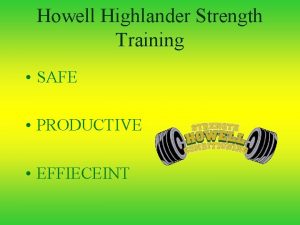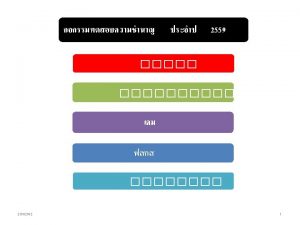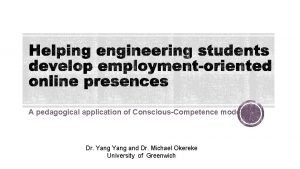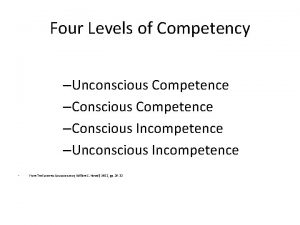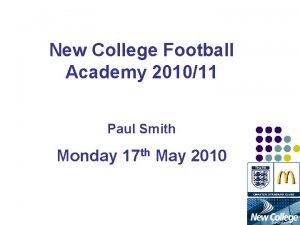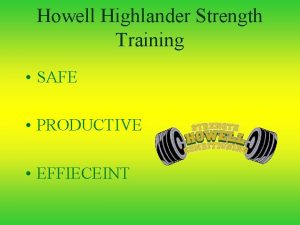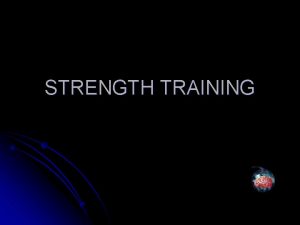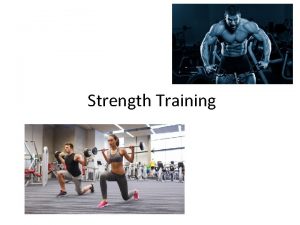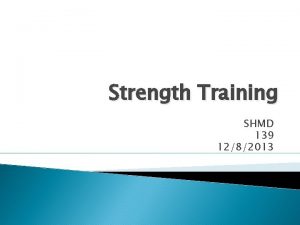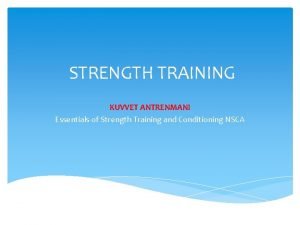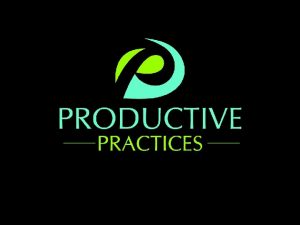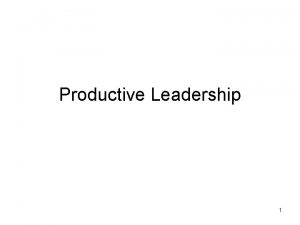Howell Highlander Strength Training SAFE PRODUCTIVE EFFIECEINT 4






















- Slides: 22

Howell Highlander Strength Training • SAFE • PRODUCTIVE • EFFIECEINT

4 P’s of Strength Training(Mark Asanovich) • Prudent • Productive • Practical • Purposeful

WHAT IS A PRUDENT STRENGTH TRAINING PROGRAM? • The answer lies in two questions: • 1. “Are the training protocols orthopedically -safe? ” • 2. “Are the training protocols physiologically-sound? ”

PRUDENT • An orthopedically safe program: has at its foundation the execution of properly performed repetitions. The emphasis should always be on HOW the repetition is lifted rather than HOW MUCH is lifted. Every effort should be made to minimize the biomechanical loading (bouncing, recoiling etc. ) on muscles, joints and connective tissue, and to maximize muscular tension. Each repetition should be lifted under control in a deliberate fashion. Flex the muscle momentarily in the midrange of the exercise when the muscle is in its “fully contracted position”. Then lower the resistance slowly to the starting position. Obviously, this is the most difficult way to train; however it is also the most productive and prudent way to train.

REPETITION RULES • REP RULE #1: Eliminate momentum while raising the weight. (2 SECONDS) • REP RULE #2: Pause momentarily (come to a complete stop, 1001) in the muscle’s contracted position. • REP RULE #3: Once you have paused in the contracted position, initiate the lowering of the weight in a smooth and controlled manner.

REPETITION RULES • REP RULE #4: Take more time to lower the weight. (4 SECONDS) • • REP RULE #5: Raise and lower the weight through the muscles full range of motion.

PRUDENT • A physiologically sound program is one that includes in its design the fundamental principles of training right, eating right, resting right and living right. As simple as it is to understand -- it is anything but simple to do. To compromise anyone of these realities would likewise compromise results. There are no “secret”, “short-cut” and/or “simple” means to achieve maximum strength gains. Rather, there is no substitute for progressively highly intense exercise, a nutritious meal plan, ample rest/recovery, and a common sense approach to a consistent training routine.

Prudent Strength Training Cont. . . • DO NOT TRY TO MIMIC A SPORTS SKILL IN THE WEIGHT ROOM • Strength training should be GENERAL and requires HEAVY RESISTANCE. • Skill Training should be SPECIFIC and requires NO ADDED RESISTANCE. • PRINCIPLE OF SPECIFICITY states that an activity must be specific to an intended skill in order to for maximal improvement – or carryover – to occur. • Specific means exact or identical, not similar or just like. • There is no exercise done in the weight room-with barbells or machines-that will expedite the learning of sports skills.

PRUDENT STRENGTH TRAINING • Orthopedically Safe • Physiologically Sound • We will train smartly to prevent injuries not create them in the weight room. • No fast, jerky movements. • Full Range of Motion. • No Olympic Style lifts.

• Athlete died in the powerlifting competition August 25, 2012 City Shahty. Igor Golushkin. He died after injuring his heart, diaphragm, broken ribs and torn abdominal cavity. He was 34 years old and was attempto lift 185 kg

PRUDENT • Obviously, it is the intent of any strength -training program to ENHANCE the physical potentials of the lifter rather than ENDANGER the lifter. • In other words, use common sense. If an exercise or training technique looks dangerous -- it probably is!

WHAT IS A PRODUCTIVE STRENGTH TRAINING PROGRAM? • The physiological basis of strength training is the overload principle. This principle requires that a muscle be progressively overloaded beyond its current capabilities to stimulate a strength/growth response. Therefore, any progressive strength training protocol that has a systematic plan of overload (i. e. increasing resistance/repetitions) will produce results! Otherwise stated, despite what strength-training program is used, it is the INTENSE and INTELLIGENT application of the lifter’s EFFORT that is most responsible for their results -- not the program. The bottom line is, and always will be, an issue of COMMITMENT and HARD WORK -- not how many sets/reps were performed.

PRODUCTIVE • Maximal effort is required to develop maximal results. HARD WORK should not be confused with MORE WORK. Truth be told, it does not take a maximal amount of work and/or time to develop maximal results. It does require maximal effort and maximal perseverance. In other words, strength development is USE IT OR LOOSE IT -- AND DON’T ABUSE IT! Train hard, chart your progression, allow ample time to rest/recovery between workouts and incorporate variety into your program to prevent overtraining and monotony.

PRODUCTIVE STRENGTH TRAINING • Systematic / Progressive Overload • Consistency / Accountability • Each person will have a workout card to follow and fill out. • Once the maximum number of repetitions is reached the weight should be increased. • Approximately 5 -10 lbs for upper body • 10 -20 lbs for the lower body • Exercise major muscle groups first

INTENSITY!!! • Many people single out INTENSITY as the single most crucial factor to success in your training • Whatever sets, reps, weight, exercises you are doing, BE INTENSE!!!! • Borrowing from Dr. Ken Leistner, “ High intensity training is going all out, not almost all out. It is taking one’s set to one’s absolute limit, not almost to the limit. ” • It involves being mentally tough

Intensity • IF YOU CAN STILL MOVE YOU’RE NOT DONE!!!!!!

WHAT IS A PRACTICAL STRENGTH TRAINING PROGRAM? • As stated, all progressive strength training protocols are PRODUCTIVE - none more significant than the other; however, not all are equally PRACTICAL. Strength can be developed either by exposing the muscle to a lengthy “high volume” of exercise or by brief “high intensity” exercise. Both training protocols have their advantages and disadvantages. However, given the time constraints for most individuals, it is much more practical to decrease the volume of training in favor of increasing the intensity of training to get the same results in less time. In other words, the training goal should be to spend the minimal amount of time to derive the maximal amount of benefits.

Practical Strength Training • Efficient use of athletes time • Workout under one hour, a minute to a minute and a half between exercises • Adapted to equipment and space available • All areas of body to be trained each time • 1 -3 sets per exercise • Vary exercises—machines, free weights, M. R. • Vary repetitions

WHAT IS A PURPOSEFUL STRENGTH TRAINING PROGRAM? • Strength training is a means to an end -- not an end in itself. It is not the goal to develop Olympic Weightlifters, Power lifters or Bodybuilders. Rather, the goal of strength training is to develop maximal levels of muscular strength to maximize functional capacity. • The development of muscular strength is the general progression of increasing the muscle’s ability to produce force. In other words, strength is a non-specific adaptation developed in the weight room whereas skills are a specific adaptation developed through guided practice. As a result, strength is developed physically in the weight room, skill, which by a separate process is developed mechanically outside the weight room. Simply stated, you build muscle in the weight room and movement outside the weight room.

Purposeful Strength Training • Perfect repetitions with maximum effort • Every time you train you are competitive • You are trying to do better than you have done in the previous workout • Football is a physical game and you need to be prepared to get hit from every possible angle.

STRENGTH Supervision Training needs to be systematic/progressive Record results to determine goals/progression Ensure variety Never attempt to simulate movements under load Give appropriate amount of time to rest and recover Total body training – neck to toes High Intensity Effort

REPETITION Rep speed under control Eliminate fast, jerky movements Perform rep through whole range of motion Emphasize negative portion Take a breath and exhale with each rep Increase tension by flexing Time between reps should be minimized If lifting on machines set seats appropriately Only perfect reps should be recorded Never use a false grip, use your thumbs
 Effieceint
Effieceint Braking tim
Braking tim Safe feed safe food
Safe feed safe food Safe people safe places
Safe people safe places Yield and tensile strength
Yield and tensile strength Formula of percentage strength
Formula of percentage strength Darrow solution half strength
Darrow solution half strength Percent strength w/v
Percent strength w/v Cuerpos de howell-jolly causas
Cuerpos de howell-jolly causas Howell 7 paires
Howell 7 paires Iboro umana
Iboro umana Corpusculo de howell-jolly
Corpusculo de howell-jolly Tripp howell
Tripp howell Rbc morphology grading system
Rbc morphology grading system Keratocyty
Keratocyty Howell v coupland
Howell v coupland Writing center unf
Writing center unf Gleaners howell
Gleaners howell Lake howell arms
Lake howell arms Howell, 1982 conscious competence model
Howell, 1982 conscious competence model Howell
Howell Levels of competence
Levels of competence Meeting point
Meeting point
